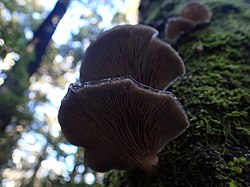Biology:Pleurotus purpureo-olivaceus
From HandWiki
Short description: Species of fungus
| Pleurotus purpureo-olivaceus | |
|---|---|

| |
| Scientific classification | |
| Domain: | Eukaryota |
| Kingdom: | Fungi |
| Division: | Basidiomycota |
| Class: | Agaricomycetes |
| Order: | Agaricales |
| Family: | Pleurotaceae |
| Genus: | Pleurotus |
| Species: | P. purpureo-olivaceus
|
| Binomial name | |
| Pleurotus purpureo-olivaceus (G.Stev.) Segedin, P.K.Buchanan & J.P.Wilkie (1995)[1]
| |
| Synonyms[3] | |
|
Resupinatus purpureo-olivaceus G.Stev. (1964) | |
Pleurotus purpureo-olivaceus is a gilled fungus native to Australia and New Zealand.[1][4][5][6] It is found on dead wood of Nothofagus trees.[2][7] Although morphologically similar to some other Pleurotus fungi, it has been shown to be a distinct species incapable of cross-breeding and phylogenetically removed from other species of Pleurotus.[1][8]
The caps of the fruit bodies are up to 7 cm (2.8 in) wide, and are dark violet to brown to olive to yellow-green, depending on light exposure. Stipes are lateral and white to yellow.[2][7]
See also
References
- ↑ 1.0 1.1 1.2 Segedin, B.P.; Buchanan, P.K.; Wilkie, J.P. (1995). "Studies in the agaricales of New Zealand: New species, new records and renamed species of Pleurotus (Pleurotaceae)". Australian Systematic Botany 8 (3): 453–482. doi:10.1071/SB9950453.
- ↑ 2.0 2.1 2.2 Segedin, B.P. (1984). "A New Species of Pleurotus (Agaricales) in New Zealand". Tane 30: 235–238. http://www.thebookshelf.auckland.ac.nz/docs/Tane/Tane-30/20%20A%20new%20species%20of%20Pleurotus.pdf.
- ↑ "Pleurotus purpureo-olivaceus (G. Stev.) Segedin, P.K. Buchanan & J.P. Wilkie 1995". MycoBank. International Mycological Association. http://www.mycobank.org/MycoTaxo.aspx?Link=T&Rec=413855. Retrieved 2011-03-14.
- ↑ Segedin, B.P.; Pennycook, S.R. (2001). "A nomenclatural checklist of agarics, boletes, and related secotioid and gasteromycetous fungi recorded from New Zealand". New Zealand Journal of Botany 39 (2): 285–348. doi:10.1080/0028825X.2001.9512739. https://www.tandfonline.com/doi/pdf/10.1080/0028825X.2001.9512739.
- ↑ Ratkowsky, D.A.; Gates, G.M. (2005). "An inventory of macrofungi observed in Tasmanian forests over a six-year period". Tasforests 16: 153–168. http://www.utas.edu.au/docs/plant_science/tasfungi/PDF%20files/tasforests_16_11.pdf.
- ↑ Petersen, Ronald H.; McCleneghan, Coleman S. (1995). "Mating systems of antipodal agarics: an unreported taxon and range extensions". New Zealand Journal of Botany 33: 93–9. doi:10.1080/0028825X.1995.10412946. https://www.tandfonline.com/doi/epdf/10.1080/0028825X.1995.10412946?needAccess=true&role=button.
- ↑ 7.0 7.1 Petersen, Ronald H. (1992). "Mating systems of three New Zealand agarics". New Zealand Journal of Botany 30 (2): 189–197. doi:10.1080/0028825X.1992.10412898.
- ↑ Thorn, Greg R.; Moncalvo, Jean-Marc; Reddy, C.A.; Vilgalys, Rytas (2000). "Phylogenetic analyses and the distribution of nematophagy support a monophyletic Pleurotaceae within the polyphyletic pleurotoid-lentinoid fungi". Mycologia 92 (2): 241–252. doi:10.2307/3761557.
External links
- Pleurotus purpureo-olivaceus in Index Fungorum
- Biological Species in Pleurotus: ISG XV: Pleurotus purpureo-olivaceus at University of Tennessee-Knoxville Mycology Lab
Wikidata ☰ Q6812631 entry
 |

